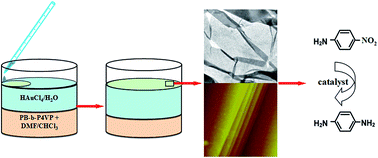A new and facile way to fabricate catalytically active block copolymer/Au nanoparticle multilayer thin films at the air/liquid interface
Abstract
A composite polymer/Au nanoparticle multilayer film was fabricated at the air/liquid interface through a new and facile self-assembly and adsorption process. A planar liquid/liquid interface was formed at first by using a DMF/CHCl3 mixed solution of polybutadiene-block-poly(4-vinylpyridine) (PB-b-P4VP) as the lower phase and a HAuCl4 aqueous solution as the upper phase. The PB-b-P4VP molecules self-organized into disk-like micelles in the mixed organic phase. Because DMF is miscible with water, DMF carried the block copolymer molecules and micelles into the upper aqueous phase, and then diffused into the HAuCl4 aqueous solution, leading to further self-assembly of the polymer molecules with the inorganic species and the formation of larger sheet aggregates. These aggregates further adsorbed at the air/liquid interface, resulting in the formation of the multilayer composite film. Most AuCl4− ions were reduced by DMF during this process, and numerous Au nanoparticles were generated and embedded in the composite film. This film exhibited unique heterogeneous catalytic properties due to its unique multilayer structure.


 Please wait while we load your content...
Please wait while we load your content...